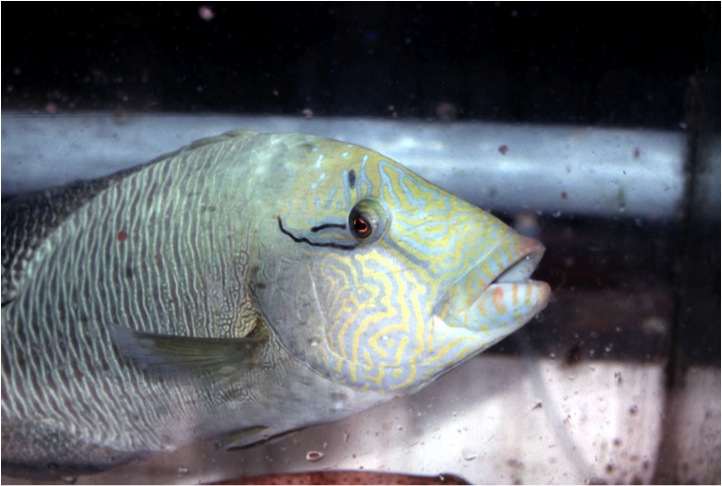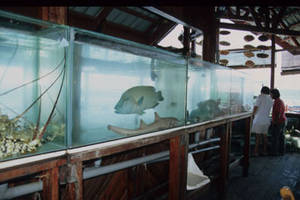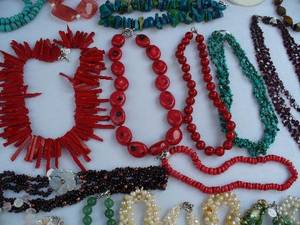Top ocean price-tags
Interview with
Sarah - This month on Naked Oceans we're diving into the many ways we trade the oceans, because there are all sorts of marine species that become incredibly valuable and sought-after once they've been caught and brought on land - and when there's lots of money to be made, people will of course go out and catch as much as they can until wild stocks start running out.
We thought we'd give you a run down of some the highest price-tags in the oceans. So, Helen what have we got to start things off?
Helen - Well, a lot of the top-priced ocean wildlife is, as you might guess, stuff that we eat. And some of it is really quite weird. 
I did my PhD on a giant denizen of coral reefs called the humphead wrasse, and yes, the adult males do have big bumps on their heads. Some people say they're ugly, but I happen to think they are really very beautiful. And in Asia they are something of a delicacy. They feature in restaurants lined with aquarium tanks packed full of live fish so that diners can pick out the fish they want to eat just moments after it's whisked out of the tank.
One of the big problems is that many large reef fish like humphead wrasse are caught using cyanide. Divers swim down, squirt just enough cyanide to stun a target fish, and then they bring it back up to the surface and hope that it revives. And the thing is that cyanide lingers on the reef where it kills all sorts of other marine life. And it's one of the destructive fishing methods highlighted by the Reefs at Risk Revisited report as being one of the top threats to reefs.
Sarah - I mean Cyanide is very Agatha Christie, dastardly murder! It's not exactly the sort of thing you'd think you'd want to put onto a reef, that doesn't sound like a very good idea at all. I know you worked on them, but have you ever tried eating humphead wrasse? Are they nice? Do they taste good?
Helen - Well, actually no I haven't tried them. I always said that I wouldn't pay my own money to buy one because that just felt wrong, but if someone offered it them I would give it a go, but that never happened. So no I haven't tried them.
 I heard they, obviously people do like them and the ultimate luxury, which is really weird I think, is a plate of their lips. They sell for hundreds of dollars. The males, these huge males, because they change sex they start life as females and become males as they get bigger, and they have these enormous lips, and people like to eat their lips. Weird! Very gross I think.
I heard they, obviously people do like them and the ultimate luxury, which is really weird I think, is a plate of their lips. They sell for hundreds of dollars. The males, these huge males, because they change sex they start life as females and become males as they get bigger, and they have these enormous lips, and people like to eat their lips. Weird! Very gross I think.
But there's another luxury seafood with a really high price tag that I have tried, and that's sea cucumbers, those tubular relatives of starfish.
Sarah - Well, funnily enough because I have actually tried sea urchins, which are another relative of the sea cucumber and I tried them in Japan and they were every strange. I'm not sure I'd really like to eat sea cucumbers, though, because they're sort of tubular and brown, and they don't really look like something you'd really want to eat.
Helen -Yeah, actually I've seen them being prepared, they're being fished out, then you have to boil them for hours to break down the tough walls inside them, and smoke them and dry them, and they do look pretty disgusting by the time they're done.
And then, I ate them while I was at a Chinese banquet in Malaysia and before I could say no someone had loaded my plate full of these slimy lumps, and I have to say they were really quite hard to chew and swallow, it was disgusting. They don't really taste of anything though, it's just that texture.
But, so I certainly, personally, couldn't imagine why you'd want to eat echinoderms. But they are considered quite the delicacy, and a growing number of people around the world think they're fantastic and sea cucumbers are one of those foods that supposed to be very good for you, they've even made anti-wrinkle creams out of them, and some people think they're at aphrodisiac.
Sarah - So, are they quite an expensive thing to buy then?
Helen - Yeah, so supposedly the most expensive soup in the world is something called "Buddha Jumps Over the Wall" and that contains various ingredients including sea cucumber and sharks fin, and the story goes that it smells so good that it would even tempt vegetarian Buddhist monks to jump over the monastery wall to try some.
Sarah - That sounds actually really disgusting, uh, no I'm not convinced by that. Not to mention the fact that it would be really bad for all the species that are involved.
Obviously people eating all this stuff and it being really popular, obviously the use for anti-wrinkle creams, and you know, it's great for you, is that causing problems for them in the wild?
Ok, so lots of people are eating sea cucumbers today - is this causing any problem for these slippery critters in the wild?
Helen - Well, yes. The problem is, as you might imagine that catching a sea cucumber is very easy. You don't have to do much more than just swim down and grab it off the sea bed, or dredge them up.
And what we've seen in the past few decades as there's been this increasing demand for sea cucumbers is a kind of boom and bust with fisheries opening up in new areas, fishermen cleaning out all they can find, and then moving on to the next place. So we've got this global trade marching around the world, hoovering up sea cucumbers as it goes.
But to be honest we can find some good news in all this, which is that we are becoming more aware of what's going on, and people are starting to talk about putting in measures to help protect sea cucumbers, because the are hardly, like we said, the most loveable of invertebrates. But there are even a few marine reserves being set up specifically for sea cucumbers including the Lau Lau Sea cucumber sanctuary in the Northern Mariana Islands in the Pacific, and you can check out on the Protected Planet website we mentioned on Naked Oceans a couple of months ago and we'll put a link to that on our website.
Sarah - So, obviously there's a bunch of high-priced marine species that aren't doing very well in the wild because the demand for them is increasing, so things like sharks caught for their fins, you've got the bluefin tuna that are sold for huge amounts of money in Japan to make sushi, and oysters as well, which we talked about on Naked Oceans last month.
But it's not just about the things that we eat that get traded is it?
 Helen - No absolutely. There's also lots of stuff we'll pay top dollar for because they look pretty. Obviously pearls are one of the most ancient jewels and they come from the oceans, they do come from freshwater pearls as well, but there are marine ones, like the fabled black Tahitian pearls.
Helen - No absolutely. There's also lots of stuff we'll pay top dollar for because they look pretty. Obviously pearls are one of the most ancient jewels and they come from the oceans, they do come from freshwater pearls as well, but there are marine ones, like the fabled black Tahitian pearls.
And like you say, with declines in oysters around the world, wild pearls are extremely rare and amazingly expensive these days.
And there's another gemstone that grows in the sea and that's coral. Since ancient times people have made jewelry and ornaments out of red, pink and black coral. And these aren't corals that build reefs in shallow waters, but they live in the deep sea and they grow branching, tree-like skeletons made from really dense calcium carbonate that can be cut and polished and it really does look quite beautiful.
Sarah - And those are the ones that get their Latin name from Medusa, the snaked-haired gorgon in the Greek myths?
Helen - Yeah exactly, the story goes her blood dropped into the sea and turned some seaweed into coral, and so there's a big group of corals called gorgonians.
But these days, many deep sea corals are being overexploited in many parts of the sea and conservationists are urging people not to buy and wear coral any more. And there are also efforts underway to have red corals listed on CITES, that's the Convention on International Trade in Endangered Species, and that would help to regulate and monitor the trade.
But really, I think what this comes down to is a lot about us as potential customers and consumers, and we're the people who, we can buy and we can decide what to eat and what to wear. And if we don't agree with exploiting corals or sea cucumbers, or whatever then we can make our say by not buying them.
Sarah - Yeah, I think there definitely is a bit role for consumer, people pressure to play, you know pressuring supermarkets and retailers of things like fish or things like coral jewelry and things, not buying specific things or calling for, right we want regulation, we want the fish that you sell to be regulated by the Marine Stewardship Council, or we want to make sure it's caught safely, and caught in a sustainable way. So I think definitely consumer pressure is going to play a big role in the future of that.
Find out more
Too Precious to Wear - Seaweb
Sea cucumbers - A global review of fisheries and trade. FAO.
Lau Lau sea cucumber sanctuary - Protected Planet.
Humphead wrasse (Cheilinus undulatus) on Fishbase
Monitoring the live reef food fish trade - Live Reef Fish Information Bulletin (PDF)










Comments
Add a comment